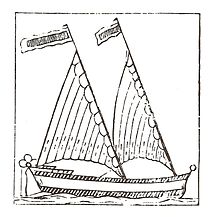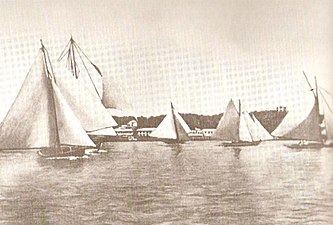Bermuda rig

ABermuda rig,Bermudian rig,orMarconi rigis a configuration ofmastandriggingfor a type ofsailboatand is the typical configuration for most modern sailboats. This configuration was developed inBermudain the 17th century; the termMarconi,a reference to the inventor of theradio,Guglielmo Marconi,became associated with this configuration in the early 20th century, because the wires that stabilize the mast of a Bermuda rig reminded observers of the wires on early radio masts.[1]
Description
[edit]
The rig consists of a triangular sail set aft of the mast with itsmainsailraised to the top of the mast; itsluffruns down the mast and is normally attached to it for its entire length; itstackis attached at the base of the mast; itsfoot(in modern versions of the rig) controlled by aboom;and itsclewattached to the aft end of the boom, which is controlled by itssheet.[2]
Originally developed for smaller Bermudian vessels, and ultimately adapted to the larger, ocean-goingBermuda sloop,the Bermuda sail is set as themainsailon themain mast.The Bermuda rigging has largely replaced the oldergaff riggedfore-and-aftsails, except notably onschooners.The traditional design as developed inBermudafeatures very tall, raked masts, a longbowsprit,and may or may not have a boom. In some configurations such as theBermuda Fitted Dinghyvast areas of sail are achieved with this rig. Elsewhere, however, the design has omitted the bowsprit, and has otherwise become less extreme.[3]
A Bermuda riggedsloopwith a singlejibis known as aBermuda sloop,aMarconi sloop,or aMarconi rig.ABermuda sloopmay also be a more specific type of vessel such as a small sailing ships traditional in Bermuda which may or may not be Bermudarigged.[4]
The foot of a Bermuda sail may be attached to the boom along its length, or in some modern rigs the sail is attached to the boom only at its ends. This modern variation of a Bermuda mainsail is known as aloose-footed main.In some early Bermudian vessels, the mainsails were attached only to the mast and deck, lacking booms. This is the case on two of the three masts of the newly builtSpirit of Bermuda,a replica of an 1830s BritishRoyal Navysloop-of-war.Additional sails were also often mounted on traditional Bermudian craft, when running down wind, which included aspinnaker,with a spinnaker boom, and additional jibs.[5]
The main controls on a Bermuda sail are:[6][7]
- Thecunninghamtightens the luff of a boom-footed sail by pulling downward on a cringle in the luff of a mainsail above the tack.[8]
- Thehalyardused to raise the head, and sometimes to tension theluff.
- Theouthaulused to tension thefootby hauling theclewtowards the end of the boom.
- Thesheetused to haul the boom down and towards the center of the boat.
- Thevangorkicking strapwhich runs between a point partway along the boom and the base of the mast, and is used to provide a downward force on the boom, which helps to prevent excessive twist in the leach, particularly when reaching or running.
History
[edit]
The development of the rig is thought to have begun with fore-and-aft rigged boats built by a Dutch-born Bermudian in the 17th century. The Dutch were influenced by Moorishlateen rigsintroduced during Spain's rule of their country. The Dutch eventually modified the design by omitting the masts, with the yard arms of the lateens beingstepped in thwarts.By this process, the yards became raked masts. Lateen sails mounted this way were known asleg-of-muttonsails in English. The Dutch called a vessel rigged in this manner abezaanjacht(nl). A bezaan jacht is visible in a painting of KingCharles IIarriving in Rotterdam in 1660. After sailing on such a vessel, Charles was so impressed that his eventual successor,the Prince of Orangepresented him with a copy of his own, which Charles namedBezaan.[9]The rig had been introduced to Bermuda some decades before this. CaptainJohn Smithreported that CaptainNathaniel Butler,who was the governor of Bermuda from 1619 to 1622, employed the Dutch boat builder, Jacob Jacobsen,[10]one of the crew of a Dutch frigate which had been wrecked on Bermuda, who quickly established a leading position among Bermuda's boat makers, reportedly building and selling more than a hundred boats within the space of three years (to the resentment of many of his competitors, who were forced to emulate his designs).[11][12]A poem published by John H. Hardie in 1671 described Bermuda's boats such:With tripple corner'd Sayls they always float, About the Islands, in the world there are, None in all points that may with them compare.[13]
Ships with somewhat similar rigs were in fact recorded in Holland during the 1600s. These early Bermuda rigged boats evidently lacked jibs or booms, and the masts appear not to have been as robust as they were to become (a boat rigged with a Bermuda or gaff mainsail and no jib would today be known as acatboat). In 1675, Samuel Fortrey, ofKew,wrote to the naval administrator andMember of Parliament,Samuel Pepys,a treatise entitledOf Navarchi,suggesting the improvement of theBermoodnrig with the addition of a boom, but evidently nothing came of this. Bermudian builders did introduce these innovations themselves, though when they first appeared has been lost to record.[2][14]
By the 1800s, the design of Bermudian vessels had largely dispensed with square topsails and gaff rig, replacing them with triangular main sails and jibs. The Bermuda rig had traditionally been used on vessels with two or more masts, with the gaff rig favoured for single-masted vessels. The reason for this was the increased height necessary for a single mast, which led to too much canvas. The solid wooden masts at that height were also too heavy, and not sufficiently strong. This changed when the boats began to be raced in the early 1800s. H. G. Hunt, a naval officer (and possibly the Henry G. Hunt who was the ActingGovernor of Bermudain 1835) concluded in the 1820s that a single-masted sloop would be superior to the schooner he had been racing and was proved correct when the yacht he had commissioned won a secret race against a schooner the night before a public race, and the public race itself the following day. Single-masted sloops quickly became the norm in Bermudian racing, with the introduction of hollow masts and other refinements.[2]
The colony's lightweightBermuda cedarvessels were widely prized for their agility and speed, especially upwind.[15]The high, raked masts and long bowsprits and booms favoured in Bermuda allowed its vessels of all sizes to carry vast areas of sail when running down-wind with spinnakers and multiple jibs, allowing great speeds to be reached. Bermudian work boats, mostly small sloops, were ubiquitous on the archipelago's waters in the 1800s, moving freight, people, and everything else about. The rig was eventually adopted almost universally on small sailing craft in the 1900s, although as seen on most modern vessels it is very much less extreme than on traditional Bermudian designs, with lower, vertical masts, shorter booms, omitted bowsprits, and much less area of canvas.[2]
The termMarconi rigwas first applied to the tall Bermuda rig used on larger racing yachts, such as theJ classused since 1914 for theAmerica's Cupinternational yacht races, as - with the many supporting cables required - it reminded observers ofGuglielmo Marconi's mast-likewirelessantennas(Marconi's first demonstrations in the United States took place in the autumn of 1899, with the reporting of the America's Cup at New York). Although sometimes treated as interchangeable withBermuda riggenerally, some purists insist thatMarconi rigrefers only to the very tall Bermuda rig used on yachts like the J-class.[2]
Gallery
[edit]-
The 1831 painting, by John Lynn, of the Bermuda sloop of theRoyal Navyupon which theSpirit of Bermudawas modelled
-
The sail training shipSpirit of Bermuda.
-
A 19th-century race in Bermuda. Visible are three Bermuda rigged and two gaff rigged sloops.
-
ABermuda Fitted Dinghyat Mangrove Bay in 2016
See also
[edit]- Glossary of nautical terms (A-L)
- Glossary of nautical terms (M-Z)
- B&R rig
- Masthead rig
- Fractional rig
Sources
[edit]- Sailing in Bermuda: Sail Racing in the Nineteenth Century,by J.C. Arnell, 1982. Published by the Royal Hamilton Amateur Dinghy Club. Printed by the University of Toronto Press.
References
[edit]- ^Stephens, William P. (January 1942).Memories of American Yachting—The Rig.New York: Motor Boating. pp. 104–6.
- ^abcdeBoats, Boffins and Bowlines: The Stories of Sailing Inventors and Innovations,by George Drower. The History Press. 1 May 2011.ISBN075246065X
- ^Chapelle, Howard Irving (1951).American Small Sailing Craft: Their Design, Development, and Construction.W. W. Norton & Company. p.233.ISBN9780393031430.
bermuda sloop.
- ^Rousmaniere, John (2014-01-07).The Annapolis Book of Seamanship: Fourth Edition.Simon and Schuster. p. 42.ISBN9781451650198.
- ^Fitzpatrick, Lynn (January 2008).Bermuda's School Spirit.Cruising World. pp. 44–6.
- ^ Schweer, Peter (2006).How to Trim Sails.Sailmate. Sheridan House, Inc. p. 105.ISBN9781574092202.
- ^ Howard, Jim; Doane, Charles J. (2000).Handbook of Offshore Cruising: The Dream and Reality of Modern Ocean Cruising.Sheridan House, Inc. p. 468.ISBN9781574090932.
- ^ Holmes, Rupert; Evans, Jeremy (2014).The Dinghy Bible: The Complete Guide for Novices and Experts.A&C Black. p. 192.ISBN9781408188002.
- ^"New Ship: The Sloop".MM Hell. Archived fromthe originalon 30 April 2009.Retrieved24 May2009.
- ^Harrison, Donald H."Jewish Sightseeing - Judah in Bermuda Part II:Under the surface, a troubled past for Jews in Bermuda".RetrievedAugust 5,2013.
- ^Sailing in Bermuda: Sail Racing in the Nineteenth Century,by J.C. Arnell, 1982. Published by the Royal Hamilton Amateur Dinghy Club. Printed by the University of Toronto Press.
- ^Belford, Paul (1 January 2011)."Ships, slaves and slipways: towards an archaeology of shipbuilding in Bermuda".Post-Medieval Archaeology.45:74–92.doi:10.1179/174581311X12983864588025.Retrieved18 May2024.
- ^Chapin, Howard M. (1926).Privateer Ships and Sailors: The First Century of American Colonial Privateering, 1625-1725.Imprimerie G. Mouton.
- ^We invented the international 'modern' Rig,by Dr.Edward C. Harris,MBE, Executive Director of theBermuda Maritime Museum.The Royal Gazette,Hamilton, Bermuda
- ^Shorto, Gavin (2018-04-05)."Bermuda in the Privateering Business".The Bermudian Magazine.Retrieved2018-05-12.
Further reading
[edit]- Rousmaniere, John (June 1998).The Illustrated Dictionary of Boating Terms: 2000 Essential Terms for Sailors and Powerboaters(Paperback).W. W. Norton & Company.p. 174.ISBN0393339181.ISBN978-0393339185
External links
[edit]- Bermuda Sloop Foundation
- Rootsweb: Excerpt ofTidewater Triumph,by Geoffrey Footner, describing development of theBaltimore clipper(large chapter on Bermuda sloops and role of Bermudian boatbuilders).
- Partial list of Bermudian-built Royal Naval vessels (fromThe Andrew and the Onions,by Lt. Cmdr. I. Strannack).
- Rootsweb: Comprehensive list ofShips of Bermuda.
- TheRoyal Bermuda Yacht Club
- Royal Hamilton Amateur Dinghy Club




